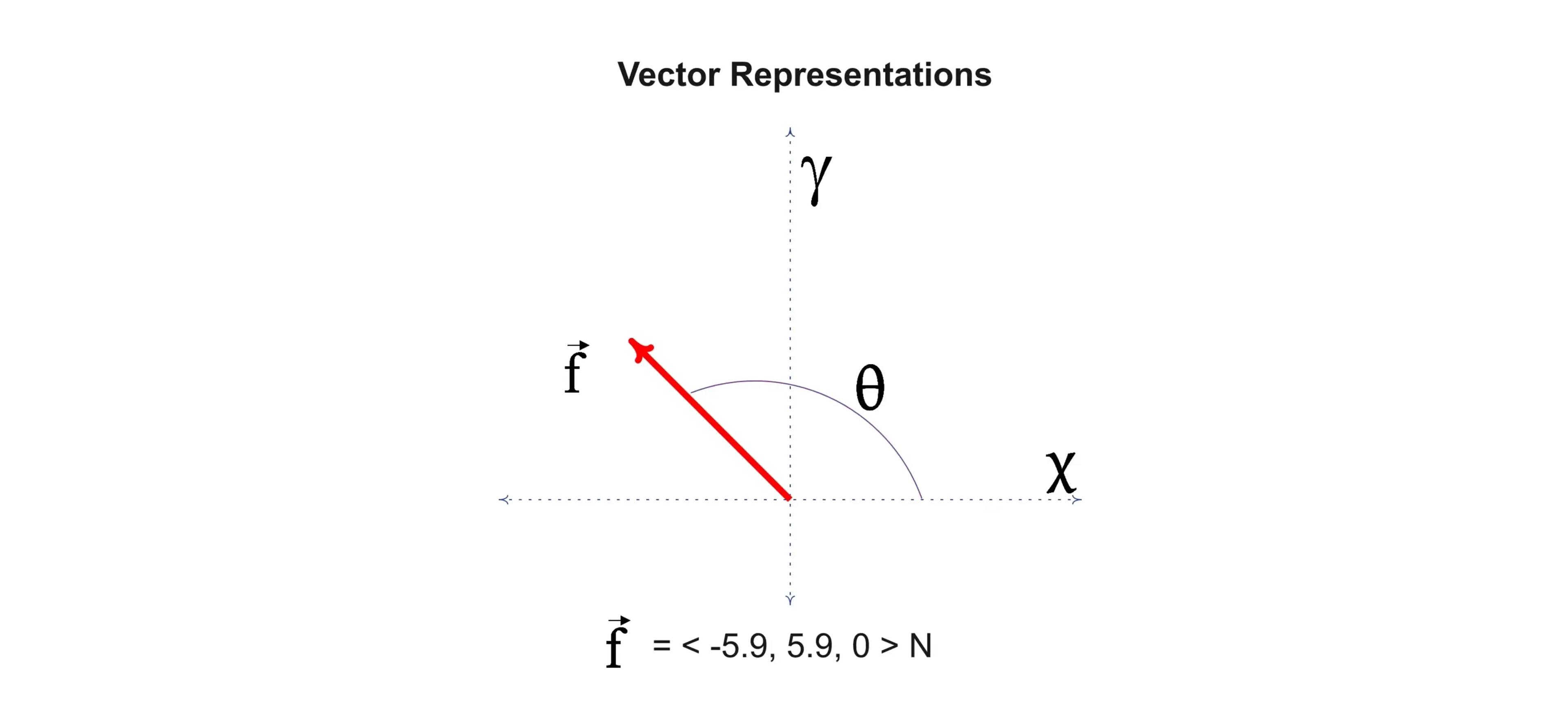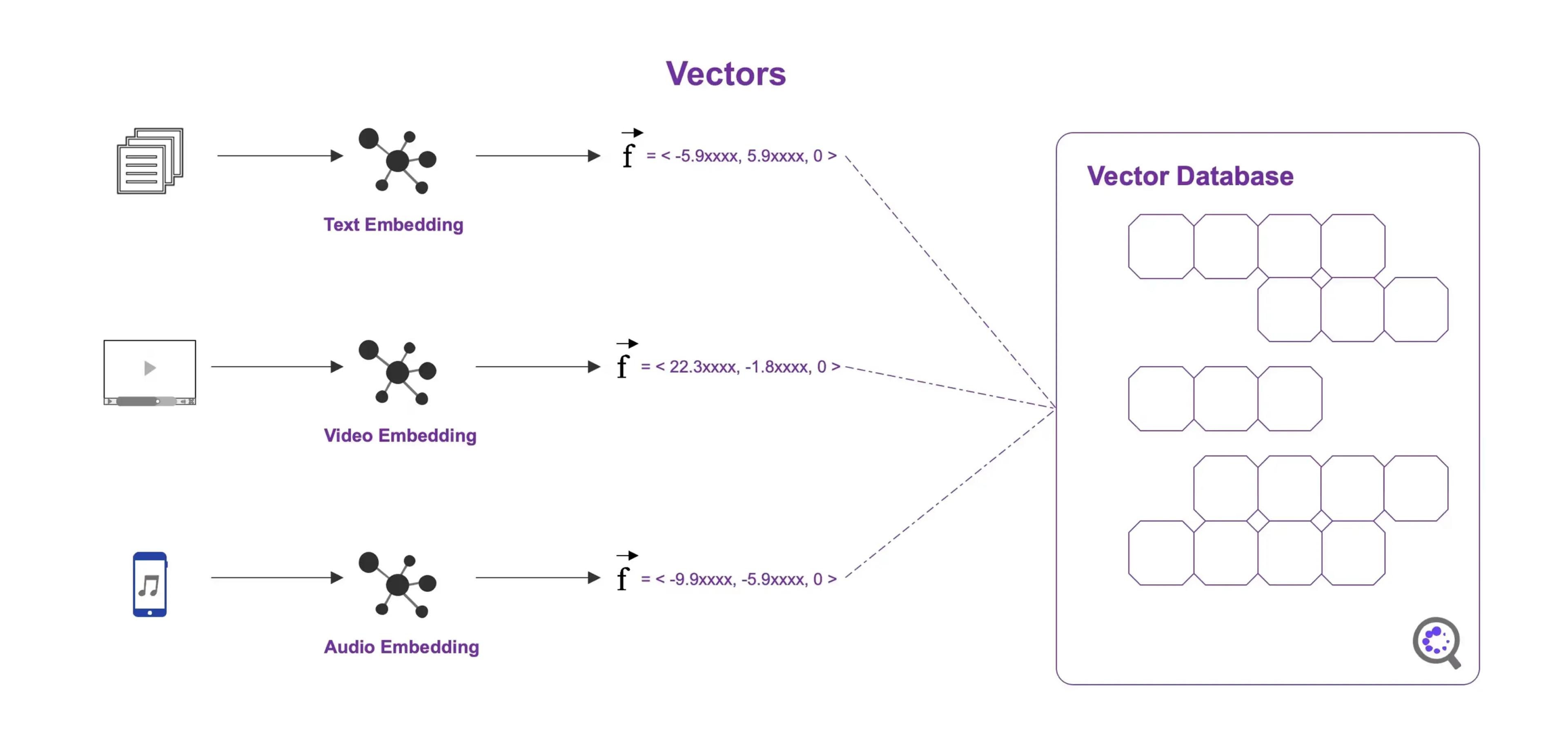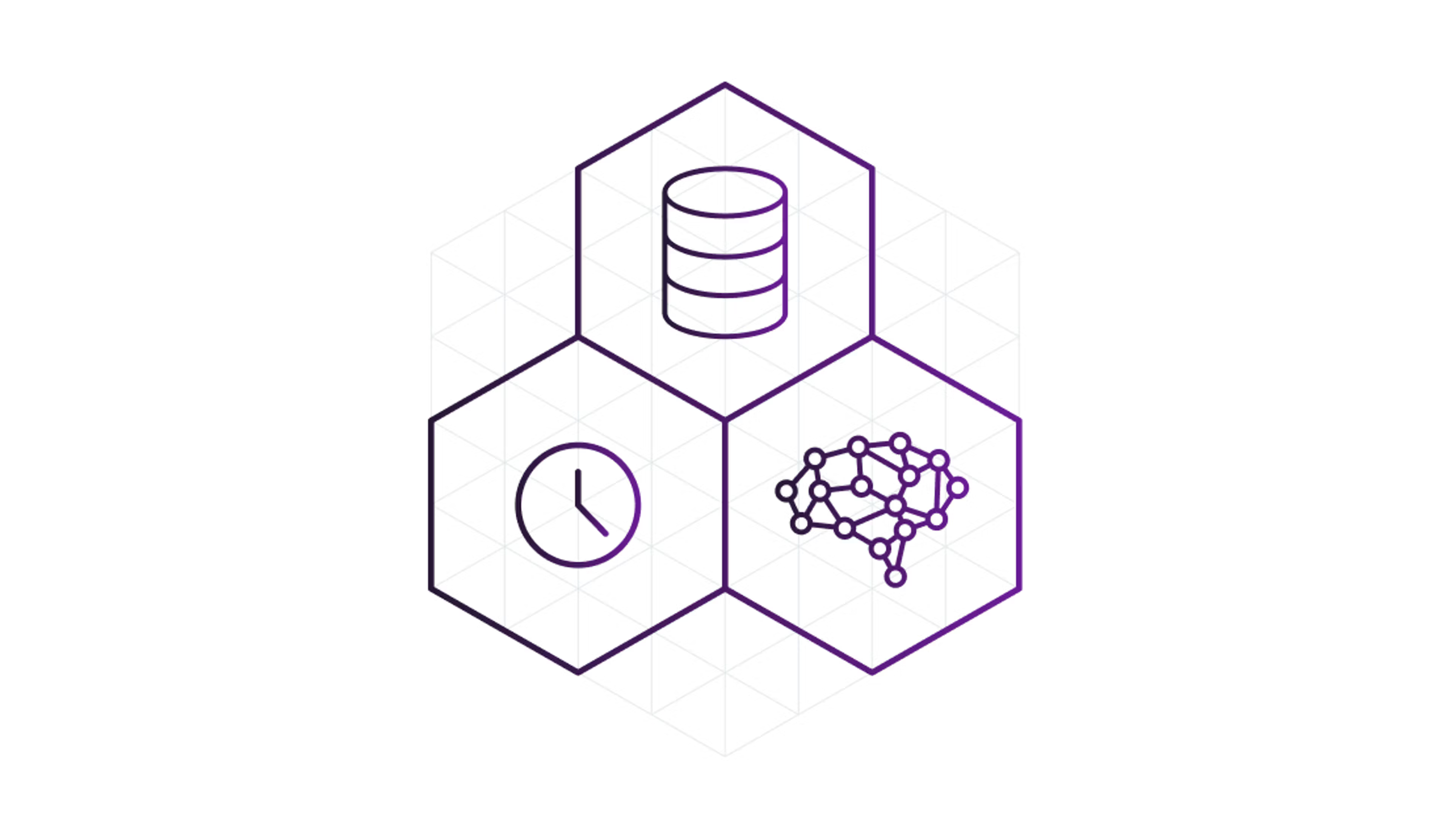What is a Vector Database?
A vector database is a specialized storage system designed to efficiently handle and query high-dimensional vector data, commonly used in AI and machine learning applications for fast and accurate data retrieval.
With the rapid adoption and innovation happening around large language models we need the ability to take large amounts of data, contextualize it, process it, and search it with meaning. Generative AI processes and applications rely on the ability to access vector embeddings, a data type that provides the semantics necessary for AI to have long-term memory processing.
Vector embeddings are the data representation that AI models (such as large language models) use and generate to make complex decisions. Like memories in the human brain, they have complexity, dimension, patterns, and relationships.
We need to store and represent all these as part of the underlying structures - which makes all of this difficult to manage. That's why, for AI workloads, we need a purpose-built database (or brain) designed for highly scalable access and specifically built for storing and accessing these vector embeddings.
Vector databases like DataStax Astra DB (built on Apache Cassandra) are designed to provide optimized storage and data access capabilities specifically for embeddings. A vector database is a type of database that is specifically designed to store and query high-dimensional vectors. Vectors are mathematical representations of objects or data points in a multi-dimensional space, where each dimension corresponds to a specific feature or attribute.

Why are vector databases important?
One of the primary values a database brings to application development is organizing and categorizing data efficiently for us. Vector databases are at the foundation of building generative AI applications because they enable vector search capabilities.
When machine learning was in its infancy, the data used by LLMs was typically small and finite. However, as generative AI has become mainstream, the amount of data used to train and augment learning has grown exponentially.
This is why vector databases are so important. They simplify fundamental operations for generative AI apps by storing large volumes of data in the structure that generative AI applications need for optimized operations.
- Optimized Semantic Search: Generative AI applications rely on data representations of high-dimensional vectors. Leveraging a vector database provides the ability to store, and more importantly, quickly retrieve vectors that are similar. Whether you are looking for similar text, images, or other outputs, being able to quickly store and retrieve that information in a mathematical format is key to building generative AI applications.
- Dynamic Data Exploration: With vector databases, generative outputs aren't limited to the interaction of a single experience. They can be stored and used across multiple engagements. This gives applications the ability to traverse a vector space and discover possible alternative solutions, possible abnormalities or variations, or different possible matching criteria. This ultimately enhances the user experience and enabling dynamic content generation and discovery.
- Scalability: As generative AI applications grow the amount of data used to provide the best user engagement, so grows the demands needed to store and retrieve that information efficiently. This is where vector databases are built specifically to provide optimized access to data as the datasets grow.
- Retrieval-Augmented Generation: As generative AI applications have advanced, one of the common approaches to provide a more flexible and scalable approach to building those applications is to use an architecture pattern like retrieval-augmented generation (RAG). Vector databases provide the glue that holds together an architecture like RAG by allowing for the storage and retrieval of large scale datasets that can then be augmented and leverage across multiple generative processes.
There are many other benefits vector databases provide. The key benefits are storing, retrieving, and interacting naturally with the large datasets that generative AI applications need.
How do vector databases work?
For generative AI to function, it needs a brain to efficiently access all the embeddings in real time. It uses this to formulate insights, perform complex data analysis, and make generative predictions of what is being asked.
Think about how you process information and memories. One prominent technique is comparing memories to past events. For example, we know not to stick our hand into boiling water because we have, at some point in the past, been burned. We know not to eat a specific food because we remember how it affected us.
This is how vector databases work. They align data (memories) for fast mathematical comparison so that generic AI models can find the most likely result. LLMs like ChatGPT, for example, need to compare what logically completes a thought or sentence by quickly and efficiently comparing all the different options it has for a given query. The result must be highly accurate and responsive.
The challenge is that generative AI can't do this with traditional scalar and relational approaches. They're too slow, rigid, and narrowly focused.
Generative AI needs a database built to store the mathematical representation its brain is designed to process. It also needs to offer extreme performance, scalability, and adaptability to make the most of all the data it has available. In other words, it needs something designed to be more like the human brain, with the ability to store memory engrams and rapidly access, correlate, and process them on demand.
With a vector database, we can rapidly load and store events as embeddings and use our vector database as the brain that powers our AI models. This provides us contextual information, long-term memory retrieval, semantically-like data correlation, and much, much more.

To enable efficient similarity search, vector databases employ specialized indexing structures and algorithms, such as tree-based structures (e.g., k-d trees), graph-based structures (e.g., k-nearest neighbor graphs), or hashing techniques (e.g., locality-sensitive hashing). These indexing methods help organize and partition the vectors in a way that facilitates fast retrieval of similar vectors.
In a vector database, the vectors are typically stored along with their associated metadata, such as labels, identifiers, or any other relevant information. The database is optimized for efficient storage, retrieval, and querying of vectors based on their similarity or distance to other vectors.
There are three steps to how a vector database works:
- Indexing: This is the step where information is encoded for storage and retrieval. Like in the human brain, indexing can have multiple different approaches (algorithms) depending on the situation. If I touch a hot pan on a stove, my brain will index that piece of information very differently from smelling fresh-cut grass. Within generative AI, data is stored as vectors. Indexing maps the vectors to the structure the data will take for optimized searching.
- Querying: This is the step used for data recall. The information we've gathered in our brain really doesn’t mean anything unless we can recall it and use it in similar situations. Take, for example, encountering another hot pan on a stove. Prior to touching that hot pan, we can query the data we have and find similar instances (nearest neighbors) to that specific piece of information. Querying simply finds the information nearest what we've provided. In some cases, this might be enough. However, in our scenario above, this querying would ideally provide us with alternatives that can be used to generate a more positive outcome.
- Post Processing: The final step, as in the human brain, is to evaluate the query and return a final answer based on re-ranking the nearest neighbors using a different or multiple similarity measurements. For example, if we see a pan on a stove and think "that pan could be hot," our brain will provide us with all the nearest information where the pan was hot or cold. However, if we're reaching for a pan on the stove that could be hot, we sure would like our brain to respond with an immediate response to not grab the pan. It could be cold but if it’s hot, it’s gonna hurt.
Vector database use cases
One of the questions that gets asked a lot is, "Do I even need a vector database?"
For small workloads, you probably don’t. However, if you're looking to leverage your data across applications and build generative AI applications that meet different use cases, having a common repository for storage and retrieval of information for those application use cases provides a more seamless interaction with a data-first approach.
Similarity and semantic search:
One of the most common use cases for a vector database is in providing similarity or semantic search capabilities. This provides a native ability to encode, store, and retrieve information based on how it relates to the data around it.
By using a vector database to store your corpus of data, applications can see how the data relates to other data. They can also see how it's semantically similar or different from all the other data within the system. Compared to traditional approaches that use keywords or key-value pairs, a vector database compares information based on high-dimensional vectors, providing 1000s of additional points of comparison.
Machine learning and deep learning:
Storing your data in a vector database also provides extensibility to machine learning or deep learning applications. Probably the most common implementation is chatbots that use natural language processing to provide a more natural interaction.
From customer information to product documentation, leveraging a vector database to store all of the relevant information provides machine learning applications with the ability to store, organize, and retrieve information from transferred learning. This enables more efficient fine-tuning of pre-trained models.
Large language models (LLMs) and generative AI:
Leveraging a vector database for generative AI applications and large language models (LLMs), like other use cases, provides the foundation by providing storage and retrieval of large corpuses of data for semantic search. Beyond that however, leveraging a vector database provides for content expansion allowing for LLMs to grow beyond the original pre-trained data.
In addition, a vector database also provides dynamic content retrieval. You can also incorporate multimodal approaches, where applications can leverage text, image, and video modalities for increased engagement.
Recommendation engines:
While recommendation engines have been mainstream for a significant time, leveraging a vector database provides exponentially more paths for making recommendations.
Previous models used keyword and relational semantics. With a vector database, your app can make recommendations on high-dimensional semantic relationships, leveraging hierarchical nearest neighbor searching to provide the most relevant and timely information.
The use cases for vector databases are pretty vast. Much of that comes down to the vector database being the next evolution in how we store and retrieve data.
Vector databases and retrieval-augmented generation (RAG)
One reason vector databases are important is that they enhance the capabilities of generative AI models when used at the core of a retrieval augmented generation architecture.
Retrieval-augmented generation (RAG) architectures provide generative AI applications with the extended ability to not only generate new content, but to use the storage and retrieval systems to incorporate contextual information from pre-existing datasets. Generative AI applications only get better with more information. As a result, pre-existing datasets tend to be fairly large in scale and distributed across multiple different applications/locations.
This is where a vector database becomes an essential asset in implementing RAG. It simplifies multiple RAG-related tasks:
- Efficient Similarity Search: Vector databases are designed to provide nearest neighbor similarity results, quickly retrieving vectors that are similar in context to a given input or prompt. For RAG-based architectures, rapidly retrieving contextual information from a known source of truth is key. Vector databases natively provide the ability to store and retrieve information structured for generative AI applications efficiently.
- Content Expansion and Diversity: The ability to augment knowledge with new viewpoints, information and context is critical for any generative AI application.
The two major concerns of generative AI adoption are (1) hallucinations, where AI goes down a rabbit hole that was never intended; and (2) data bias, where the AI can only formulate an option based on data biased towards one viewpoint or another.
The only way to limit these is to constantly update, validate, and contextualize your data. If generative AI applications only pull in limited information and don’t incorporate new data into their learning, they will be more prone to error.
Vector databases provide a simplified approach to leveraging past, present, and future information by contextualizing that information for generative AI applications to retrieve and augment their behaviors and outputs.
- Dynamic Multimodal Data Retrieval: The true power of a RAG architecture lies in the ability to bring together multiple different approaches to content generation and to bridge the gap between things like predictive AI and generative AI. When using RAG powered by a vector database, generative AI applications can tap into multiple different modalities, using to generate contextual relevant outputs across multiple different domains, like text, audio, images and more.
What are the differences between vector databases vs traditional databases?
A traditional database stores multiple standard data types like strings, numbers, and other scalar data types in rows and columns. You query rows in the database using either indexes or key-value pairs that are looking for exact matches. The query returns the relevant rows for those queries.
By contrast, a vector database introduces a new data type, a vector. It builds optimizations around this data type to enable fast storage, retrieval, and nearest neighbor search semantics.
Traditional relational databases were optimized to provide vertical scalability around structure data. Traditional NoSQL databases were built to provide horizontal scalability for unstructured data. Solutions like Apache Cassandra, have been built to provide optimizations around both structured and unstructured data, with the addition of features to store vector embeddings. That makes solutions like DataStax Astra DB ideally suited for traditional and AI-based storage models.
One of the biggest differences with a vector database is that traditional models have been designed to provide exact results. Vector databases store data as a series of floating point numbers. Searching and matching data doesn’t have to be an exact match; it can instead find the most similar results to our query.
Vector databases use different algorithms that all participate in Approximate Nearest Neighbor (ANN) search, retrieving large volumes of related information to quickly and efficiently. This is where a purpose-built vector database, like DataStax Astra DB, provides significant advantages for generative AI applications. Traditional databases simply can’t scale to the amount of high-dimensional data that AI requires. AI applications need the ability to store, retrieve, and query closely-related data in a highly distributed, highly flexible solution.
Advantages of vector databases
Vector databases offer several key benefits that make them highly valuable in various gen-AI applications, especially those involving complex and large-scale data analysis. Here are some of the primary advantages:
Efficient handling of high-dimensional data
Vector databases are specifically designed to manage high-dimensional data efficiently. Traditional databases often struggle with the complexity and size of these datasets. Vector databases excel in storing, processing, and retrieving data from high-dimensional spaces without significant performance degradation.
Enhanced search capabilities
One of the most significant advantages of vector databases is their ability to perform similarity and semantic searches. They can quickly find data points most similar to a given query. That's crucial for applications like recommendation engines, image recognition, and natural language processing.
Scalability
Vector databases must be highly scalable, capable of handling massive datasets without a loss in performance. This scalability is essential for businesses and applications that generate and process large volumes of data regularly.
Speed and accuracy
Vector databases offer faster query responses compared to traditional databases, especially when dealing with complex queries in large datasets. This speed doesn't come at the cost of accuracy, as vector databases can provide highly relevant results due to their advanced algorithms. For more information on speed and accuracy, please see GigaOm's report on vector database performance comparisons.
Improved machine learning and AI integration
Vector databases are particularly well-suited for AI and machine learning applications. They can store and process the data necessary for training and running machine learning models, particularly in fields like deep learning and natural language processing.
Facilitates advanced analytics and insights
By enabling complex data modeling and analysis, vector databases allow organizations to gain deeper insights from their data. This capability is crucial for data-driven decision-making and predictive analytics.
Personalization
These databases support the development of personalized user experiences by analyzing user behavior and preferences. This is particularly useful in marketing, e-commerce, and content delivery platforms where personalization can significantly enhance user engagement and satisfaction.
How vector databases help boost AI
One of the biggest benefits vector databases bring to AI is the ability to leverage existing models across large datasets by enabling efficient access and retrieval of data for real-time operations. A vector database provides the foundation for the same type of memory recall we use in our organic brains.
With a vector database, artificial intelligence is broken into cognitive functions (large language models), memory recall (vector databases), specialized memory engrams and encodings (vector embeddings), and neurological pathways (data pipelines).
Working together, these processes enable artificial intelligence to learn, grow and access information seamlessly.
The vector database holds all of the memory engrams. It provides cognitive functions with the ability to recall information that triggers similar experiences. This is similar to how, when an event occurs, our human memory recalls other events that invoke the same feelings of joy, sadness, fear, or hope.
With a vector database, generative AI processes can access large sets of data. They correlate that data in a highly efficient way and use it to make contextual decisions on what comes next.
When tapped into a nervous system - i.e., data pipelines - this model enables storing and accessing new memories as they're made. This gives AI models the power to learn and grow adaptively by tapping into workflows that provide history, analytics, or real-time information.
Whether you're building a recommendation system, an image processing system, or anomaly detection, you need a highly efficient, optimized vector database like Astra DB at the core. Astra DB is designed and built to power the cognitive process of AI that can stream data as data pipelines from multiple sources, like Astra Streaming. It leverages those to grow and learn, providing faster, more efficient results over time.
Get started with the industry-leading vector database for scalable generative AI
With the rapid growth and acceleration of generative AI across all industries, we need a purpose-built way to store the massive amount of data used to drive contextual decision-making.
Vector databases have been purpose-built for this task, providing a specialized solution for managing vector embeddings for AI usage. This is where the true power of a vector database derives: in contextualizing data, both at rest and in motion, to provide the core memory recall for AI processing.
While this may sound complex, vector search on Astra DB takes care of all of this for you with a fully integrated solution that provides all of the pieces you need. It provides a nervous system for retrieval, access, and processing of vector embeddings in an easy-to-use cloud platform. Try for free today.
 )
)